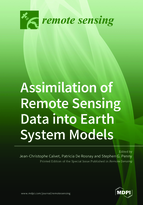Assimilation of Remote Sensing Data into Earth System Models
A special issue of Remote Sensing (ISSN 2072-4292).
Deadline for manuscript submissions: closed (31 December 2018) | Viewed by 53227
Special Issue Editors
Interests: land surface modeling; remote sensing; data assimilation; hydrometeorology; carbon cycle
Interests: numerical weather prediction; remote sensing; land data assimilation; coupled assimilation; soil moisture; snow; hydrology
Special Issues, Collections and Topics in MDPI journals
2. Physical Sciences Division (PSD) at the Earth System Research Laboratory (ESRL) of the National Oceanographic and Atmospheric Association (NOAA)
Interests: ocean data assimilation; coupled-model data assimilation; dynamical systems; ensemble
Special Issue Information
Dear Colleagues,
Earth system approaches are emerging for a number of applications, including numerical weather prediction, hydrological forecast, climate impact studies, ocean dynamics, carbon cycle monitoring, etc. They rely on coupled modelling techniques, using Earth system models (ESMs) that account for an increased level of complexity of (coupled) processes and interactions between atmosphere, ocean, sea-ice and terrestrial surfaces. A crucial component of Earth System approaches is the development of coupled assimilation of satellite observations to ensure consistent initialization at the interface between the different sub-systems. For example, a coupled ocean-atmosphere data assimilation system ensures consistent sea surface temperature and near surface atmospheric conditions and coupled land-atmosphere assimilation produces consistent soil moisture and air temperature analyses.
There is a large range of coupled data assimilation (CDA) approaches, from weakly coupled (coupled first guess model but separate analyses) to strongly coupled assimilation (single cost function and control vector). Intermediate levels of coupling (quasi-CDA) allow observations in one subsystem to provide increments in other subsystems. CDA development in ESMs will open possibilities to further exploit satellite observations that are sensitive to both the lowest levels of the atmosphere and the underlying system (land, urban surfaces, ocean or sea-ice).
The integration of satellite-derived observations into ESMs or into ESM modules can also help minimize modeling uncertainties. The assimilation of new remote sensing products is expected to benefit to a wide range of applications, including weather, subseasonal to seasonal, seasonal, and interannual climate prediction, and climate reanalysis. Satellite-derived climate data records of essential climate variables are now available for the different components of the Earth system, including terrestrial and ocean surfaces. Some cover more than three decades.
In this Special Issue, we welcome studies on assimilation of satellite observations in models and presenting the most recent advances in,
- ESM reanalysis incorporating satellite-derived observations,
- Land reanalysis,
- Ocean and sea ice reanalysis,
- Coupled data assimilation,
- Uncertainty characterization of ESMs and satellite-derived essential climate variables.
Dr. Jean-Christophe Calvet
Dr. Patricia De Rosnay
Dr. Stephen G. Penny
Guest Editors
Manuscript Submission Information
Manuscripts should be submitted online at www.mdpi.com by registering and logging in to this website. Once you are registered, click here to go to the submission form. Manuscripts can be submitted until the deadline. All submissions that pass pre-check are peer-reviewed. Accepted papers will be published continuously in the journal (as soon as accepted) and will be listed together on the special issue website. Research articles, review articles as well as short communications are invited. For planned papers, a title and short abstract (about 100 words) can be sent to the Editorial Office for announcement on this website.
Submitted manuscripts should not have been published previously, nor be under consideration for publication elsewhere (except conference proceedings papers). All manuscripts are thoroughly refereed through a single-blind peer-review process. A guide for authors and other relevant information for submission of manuscripts is available on the Instructions for Authors page. Remote Sensing is an international peer-reviewed open access semimonthly journal published by MDPI.
Please visit the Instructions for Authors page before submitting a manuscript. The Article Processing Charge (APC) for publication in this open access journal is 2700 CHF (Swiss Francs). Submitted papers should be well formatted and use good English. Authors may use MDPI's English editing service prior to publication or during author revisions.








